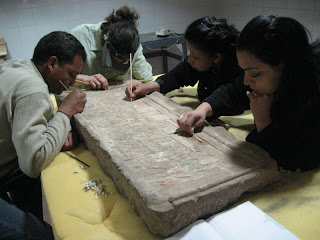

For several weeks now we've been excavating the inner face of the Precinct's enclosure wall where it runs along the north side of the Forecourt of Temple A, in the northeast corner of the Precinct. The photo on the left is a view to the north of the area. The wall itself is interesting. The original wall, which suffered considerable slippage at some point, was re-faced, probably in the Ptolemaic or Roman Periods, with mud brick that was coated in plaster. The two phases can be seen in the photo on the right, which looks east along the wall. Visible in both photos is a slab of sandstone leaning against the face of the wall; it is not part of the wall itself.

 On January 29 we turned the block over and got a real surprise: a gilded and painted raised relief lintel. These 2 photos show the lintel as found, and the impression it left in the mud brick wall behind it.
On January 29 we turned the block over and got a real surprise: a gilded and painted raised relief lintel. These 2 photos show the lintel as found, and the impression it left in the mud brick wall behind it. We immediately called the local SCA officials. Mansour Boreik, General Director for Luxor (left) and Ibrahim Soliman, Director for Karnak (right) examine the newly-discovered object with SCA inspector Ahmed Araby Yunis. Drs. Boreik and Soliman decided it was a significant enough find to be reported to the main SCA offices in Cairo.
We immediately called the local SCA officials. Mansour Boreik, General Director for Luxor (left) and Ibrahim Soliman, Director for Karnak (right) examine the newly-discovered object with SCA inspector Ahmed Araby Yunis. Drs. Boreik and Soliman decided it was a significant enough find to be reported to the main SCA offices in Cairo.
 We moved the lintel, whose decoration is rather fragile, to our on-site magazine where SCA conservator Khaled Mohammed Wassel began the painstaking work of cleaning the object.
We moved the lintel, whose decoration is rather fragile, to our on-site magazine where SCA conservator Khaled Mohammed Wassel began the painstaking work of cleaning the object.
 Jacobus van Dijk, of the University of Groningen in the Netherlands, and I examine the lintel's decoration while Khaled goes on with the cleaning. The lintel is 110 cm long, 45 cm high and 8 cm deep. Based on its style and its inscriptions, it dates to the Ptolemaic or Roman Period (late 4th to early 1st century BC).
Jacobus van Dijk, of the University of Groningen in the Netherlands, and I examine the lintel's decoration while Khaled goes on with the cleaning. The lintel is 110 cm long, 45 cm high and 8 cm deep. Based on its style and its inscriptions, it dates to the Ptolemaic or Roman Period (late 4th to early 1st century BC). Here's the lintel after its initial cleaning. The top is a cavetto cornice adorned with a gilded sun disk from which hang two gilded uraeus-serpents representing Upper and Lower Egypt. Below is a temple-shaped scene with 5 child-gods sitting on lotuses rising from strips of water, all of which are symbolic of birth. They face an altar heaped with offerings beyond which stand two female deities. Each child-god holds his finger to his mouth (typical of ancient Egyptian depictions of children) and carries the royal crook and flail.
Here's the lintel after its initial cleaning. The top is a cavetto cornice adorned with a gilded sun disk from which hang two gilded uraeus-serpents representing Upper and Lower Egypt. Below is a temple-shaped scene with 5 child-gods sitting on lotuses rising from strips of water, all of which are symbolic of birth. They face an altar heaped with offerings beyond which stand two female deities. Each child-god holds his finger to his mouth (typical of ancient Egyptian depictions of children) and carries the royal crook and flail.
The first of the figures to the right is a female Bes-image, the second a crowned, pregnant hippopotamus with a crocodile on her back and holding a hieroglyph for "protection" – a formidable mother symbol.
Temple A was a mammisi, or temple celebrating the birth of a child-god (here Khonsu, son of Amun and Mut) -- and eventually of the king himself -- from the Third Intermediate Period through the Roman Period, so the discovery here of a lintel with birth-related scenes should not come as a surprise.


The Egyptian government decided that the lintel was of sufficient significance that its discovery should be announced formally by Farok Hosni, Egyptian Minister of Culture. They also determined that it really belongs in the Luxor Museum, where visitors can enjoy it. Therefore, once the lintel was cleaned and stabilized, it was packed it in a specially constructed box, carried out of the Precinct and moved to the Museum. Dr. Saymia Abdel Aziz Abdel Razik, Assistant Director of the Luxor Museum (right) and Khaled examine the lintel in the museum's conservation lab.
Dr. Saymia Abdel Aziz Abdel Razik, Assistant Director of the Luxor Museum (right) and Khaled examine the lintel in the museum's conservation lab.
 Lisa Bruno, Brooklyn Museum objects conservator and a member of the Mut Expedition, arrived on February 4 and with Khaled was able to get her first look at the lintel the next day in the Luxor Museum conservation laboratory.
Lisa Bruno, Brooklyn Museum objects conservator and a member of the Mut Expedition, arrived on February 4 and with Khaled was able to get her first look at the lintel the next day in the Luxor Museum conservation laboratory. Lisa, Khaled and the museum's conservators work as a team on treating the lintel, which will go on display in the Luxor Museum in the near future.
Lisa, Khaled and the museum's conservators work as a team on treating the lintel, which will go on display in the Luxor Museum in the near future.
Richard Fazzini
Director, Mut Expedition




